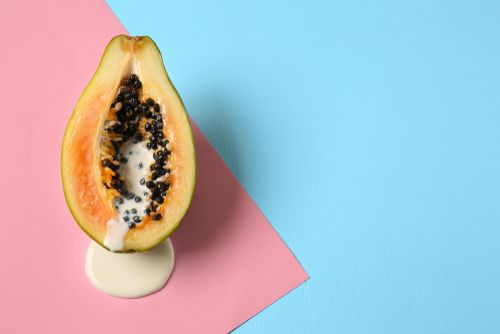The genital region is a sensitive part of the body and needs some special care to stay healthy.
Infections and inflammations are more likely to happen when there is no proper cleaning of the site, indiscriminate use of irritating products or imbalance of the vaginal flora.
If these problems occur, there are ointments that can help to treat and eliminate the discomfort caused by illnesses.
Learn more about gynecological ointments and the characteristics of each one!
In this article you will find:
- What is gynecological ointment for?
- What are gynecological ointments?
- Gynecological ointments with corticoids
- What are single-dose or single-use gynecological ointments?
- Where to buy gynecological ointment?
What is gynecological ointment for?

Gynecological ointments are used to treat infections in a woman’s intimate region, usually caused by fungi or bacteria.
Vaginal infections can originate from various causes, such as poor intimate hygiene, wearing very tight clothes, poor ventilation in the region and even a hormonal imbalance.
The use of ointments, when recommended by a physician, helps to alleviate symptoms and discomfort that may appear alone or together. Among the most common are:
Allergy
Vaginal allergy can be triggered as a reaction to products such as intimate soap, external absorbent, underwear fabric or even the material that condoms are manufactured.
Symptoms are usually irritation of the site, causing itching and redness.
By eliminating what causes the allergy, the symptoms usually disappear. But if they persist, ointments can help.
Candidiasis
Vaginal thrush is a very common fungal infection caused by the fungus Candida Albicans.
It usually occurs in times of stress, low immunity or overuse of antibiotics, which cause an imbalance in the vaginal flora.
The microbiota of the vagina is full of beneficial bacteria needed to regulate and protect the region.
The Candida Albicans fungus naturally inhabits the vagina, however, in cases where there is an imbalance of flora, it proliferates more than it should, causing candidiasis.
Symptoms are usually intense itching, burning, local pain and white discharge, and there may also be swelling in the vulva — the outer area of the female genital organ.
What can be white discharge?
Inflammation
Vaginitis is usually called vaginitis, when it occurs only in the inner area of the genitals, or vulvovaginitis, when it involves the inner and outer region. They can be infectious or not.
In cases of infectious vaginitis, it is caused by bacteria, fungi or parasites, which cause inflammation in the area.
In non-infectious cases, however, it can be caused by irritation in the region, due to allergy to products, such as intimate soaps and gels, or the use of very tight clothes.
Skin changes caused by the period of menopause or pregnancy can also lead to inflammation.
Runoff

There are different types of discharge, and each can have a different cause. In general, discharges can be divided into 2: physiological and pathological.
Physiological discharge is normally produced by a woman and helps to regulate vaginal health. It has a color that varies between whitish and transparent, and has no smell.
It serves to maintain the vagina’s natural lubrication and hygiene.
A pathological discharge is one that is not normally produced and indicates that something is not right and could be caused by a bacteria, fungus or parasite.
It can have a varied coloration, being brown or yellowish. Along with this, in general, there are symptoms such as burning and itching.
It generally originates from an allergy to the use of intimate soaps, tight clothing or infections.
There is also the pinkish discharge, which can be the result of remnants of menstruation or nidation.
What can be yellow discharge?
Burning
The burning sensation in the vagina can be caused by several factors such as allergies, infections, dermatitis and even friction damage in the region.
When accompanied by other symptoms such as itching and discharge, it can be a sign of Candidiasis.
What are gynecological ointments?
For the treatment of different problems and symptoms related to vaginal diseases, there are specific ointments.
Among the most popular are:
Umma
Umma is an ointment whose main component is Butoconazole Nitrate.
This substance promotes an antifungal action, that is, it fights infections caused by fungi, especially Candida Albicans – which causes candidiasis.
The product packaging comes with an applicator and is a single dose. Administration is via the vaginal route.
Ginna
Ginna is a medicine used to treat vaginal infections caused by fungi in general.
It is composed of Fenticonazole Nitrate, which provides an antimycotic effect against fungi and an antibacterial effect in the case of some bacteria.
The application route is vaginal, and the product comes with an applicator. Administration should preferably be done at night, before bedtime.
Kronel
Kronel is a medicine in gel form, recommended for the treatment of vaginitis and cervicovaginitis — when the infection affects the vagina and cervix.
Its active ingredient is Schinus terebinthifolius, and it acts to combat inflammatory and infectious processes.
Nystatin
Nystatin is an active ingredient found in ointments with trade names such as Nistrazin, or in the form of a generic medicine.
It is indicated for the treatment of vaginal candidiasis, as it has a mechanism of action against fungi.
The route of administration is vaginal and comes with an applicator with the product.
Clotrimazole
Clotrimazole is an active ingredient found in some ointments with commercial names such as Canesten cream, indicated for the treatment of infections in the external female intimate region.
The substance has antimycotic action and its use is topical.
Intimate ointment for discharge: what are the options?
Gynecological ointments with corticoids

Corticosteroids are hormones produced by the adrenal glands and, among other things, are responsible for regulating the body’s metabolism.
Due to their anti-inflammatory potential, they are synthetically present in some medications, in order to intensify their action.
In the case of gynecological ointments, in general, steroids help to combat allergies and skin irritations.
However, as it is a substance already produced naturally by the body, the use of these remedies must be done with caution and only under medical supervision, since excessive or prolonged use can cause health risks.
Some ointments that have the substance are:
Gynax N
Gynax N is a cream used to treat diseases in the female genital region, caused by fungi and bacteria.
It has in its composition a set of substances that eliminate fungal and bacterial proliferation, including Dexamethasone, a corticoid that provides anti-inflammatory action and helps to eliminate edema.
The route of administration is vaginal.
Trivagel-N
Trivagel-N is a drug with antifungal and antibacterial action, which works to combat the proliferation of bacteria and fungi in the vaginal mucosa.
Its formulation includes, among others, Dexamethasone, a corticoid that promotes anti-inflammatory action and eliminates possible edema.
The route of administration is vaginal and the product comes with an applicator.
What are single-dose or single-use gynecological ointments?
Dosage or single use ointments are those in which the amount of product in the package is enough for just 1 application.
In general, these ointments are used to treat clinical conditions, in 1 application.
Among the single-dose ointments are:
Gynazole-1
Gynazole-1 is an ointment indicated for the treatment of vaginal infections caused by the fungus Candida albicans. Its active ingredient is butoconazole nitrate and has an antifungal action.
The product comes with an applicator and the administration is via vaginal and single dose.
Ovum Fentizol
Fentizol Ovum is an ointment recommended for the treatment of fungal infections.
In its composition there is the Fenticonazole Nitrate, a substance that promotes the blocking of fungal growth.
The application is done vaginally and is a single dose. The product packaging is accompanied by an applicator.
Where to buy gynecological ointment?
Gynecological ointments can be found at physical and online pharmacies.
It is important to always consult a physician who will assess the best option for each clinical case.
In general, ointments require an ordinary white medical prescription.
Itching, discharge and pain are some symptoms that can make a woman’s daily life stressful and uncomfortable.
To combat these adversities, there are ointments that reduce discomfort and eliminate the causes of the problem.







